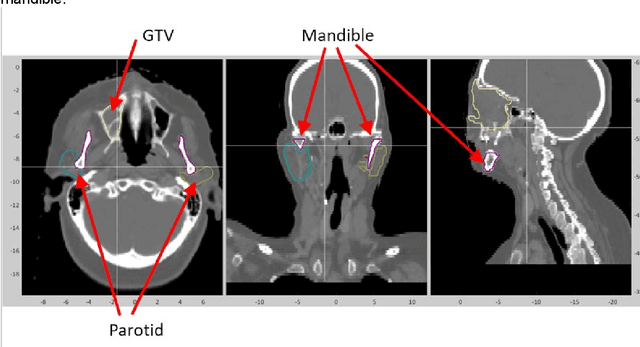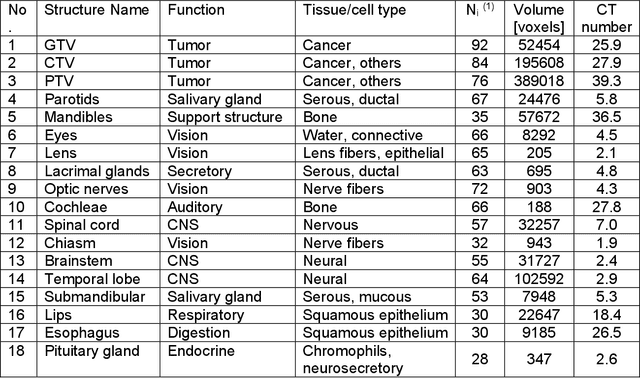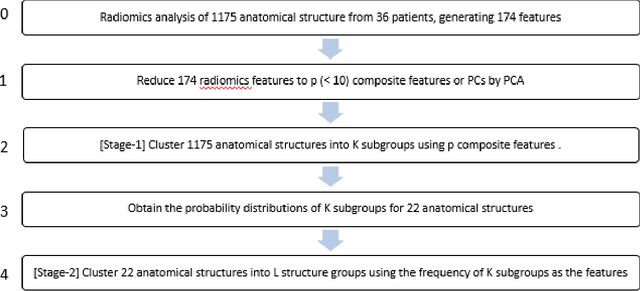Yoichi Watanabe
Department of Radiation Oncology, University of Minnesota Medical School, Minneapolis, MN, USA
Radiomics as a measure superior to the Dice similarity coefficient for tumor segmentation performance evaluation
Oct 30, 2023Abstract:In high-quality radiotherapy delivery, precise segmentation of targets and healthy structures is essential. This study proposes Radiomics features as a superior measure for assessing the segmentation ability of physicians and auto-segmentation tools, in comparison to the widely used Dice Similarity Coefficient (DSC). The research involves selecting reproducible radiomics features for evaluating segmentation accuracy by analyzing radiomics data from 2 CT scans of 10 lung tumors, available in the RIDER Data Library. Radiomics features were extracted using PyRadiomics, with selection based on the Concordance Correlation Coefficient (CCC). Subsequently, CT images from 10 patients, each segmented by different physicians or auto-segmentation tools, were used to assess segmentation performance. The study reveals 206 radiomics features with a CCC greater than 0.93 between the two CT images, indicating robust reproducibility. Among these features, seven exhibit low Intraclass Correlation Coefficients (ICC), signifying increased sensitivity to segmentation differences. Notably, ICCs of original shape features, including sphericity, elongation, and flatness, ranged from 0.1177 to 0.995. In contrast, all DSC values exceeded 0.778. This research demonstrates that radiomics features, particularly those related to shape and energy, can capture subtle variations in tumor segmentation characteristics, unlike DSC. As a result, Radiomics features with ICC prove superior for evaluating a physician's tumor segmentation ability and the performance of auto-segmentation tools. The findings suggest that these new metrics can be employed to assess novel auto-segmentation methods and enhance the training of individuals in medical segmentation, thus contributing to improved radiotherapy practices.
Classification of anatomic structures in head and neck by CT-based radiomics
May 17, 2022



Abstract:Background and Purpose: Radiomics features are used to identify disease types and predict therapy outcomes. However, how the radiomics features are different among different anatomical structures has never been investigated. Hence, we analyzed the radiomics features of 22 anatomical structures in the head and neck area in CT images. Furthermore, we studied whether CT radiomics can classify anatomical structures of the head and neck using unsupervised machine-learning techniques. Materials and methods: We obtained IMRT/VMAT treatment planning data from 36 patients treated for head and neck cancers in a single institution. There were 1357 contours of more than 22 anatomical structures drawn on planning CTs. We calculated 174 radiomics features using the SIBEX program. First, we tested whether the radiomics features of anatomical structures were unique enough to classify all contours into 22 groups. We then developed a two-stage clustering technique to classify 22 anatomic structures into sub-groups with similar physiological or biological characteristics. Results: The heatmap of 174 radiomics features of 22 anatomical structures showed a distinct difference among tumors and other healthy structures. Radiomics features have allowed us to identify the eyes, lens, submandibular, pituitary glands, and thyroids with over 90% accuracy. The two-stage clustering of 22 structures resulted in six subgroups, which shared common characteristics such as fatty and bony tissues. Conclusions: We have shown that anatomical structures in head and neck tumors have distinguishable radiomics features. We could observe similarities of features among subgroups of the structures. The results suggest that CT radiomics can help distinguish the biological characteristics of head and neck lesions.
 Add to Chrome
Add to Chrome Add to Firefox
Add to Firefox Add to Edge
Add to Edge